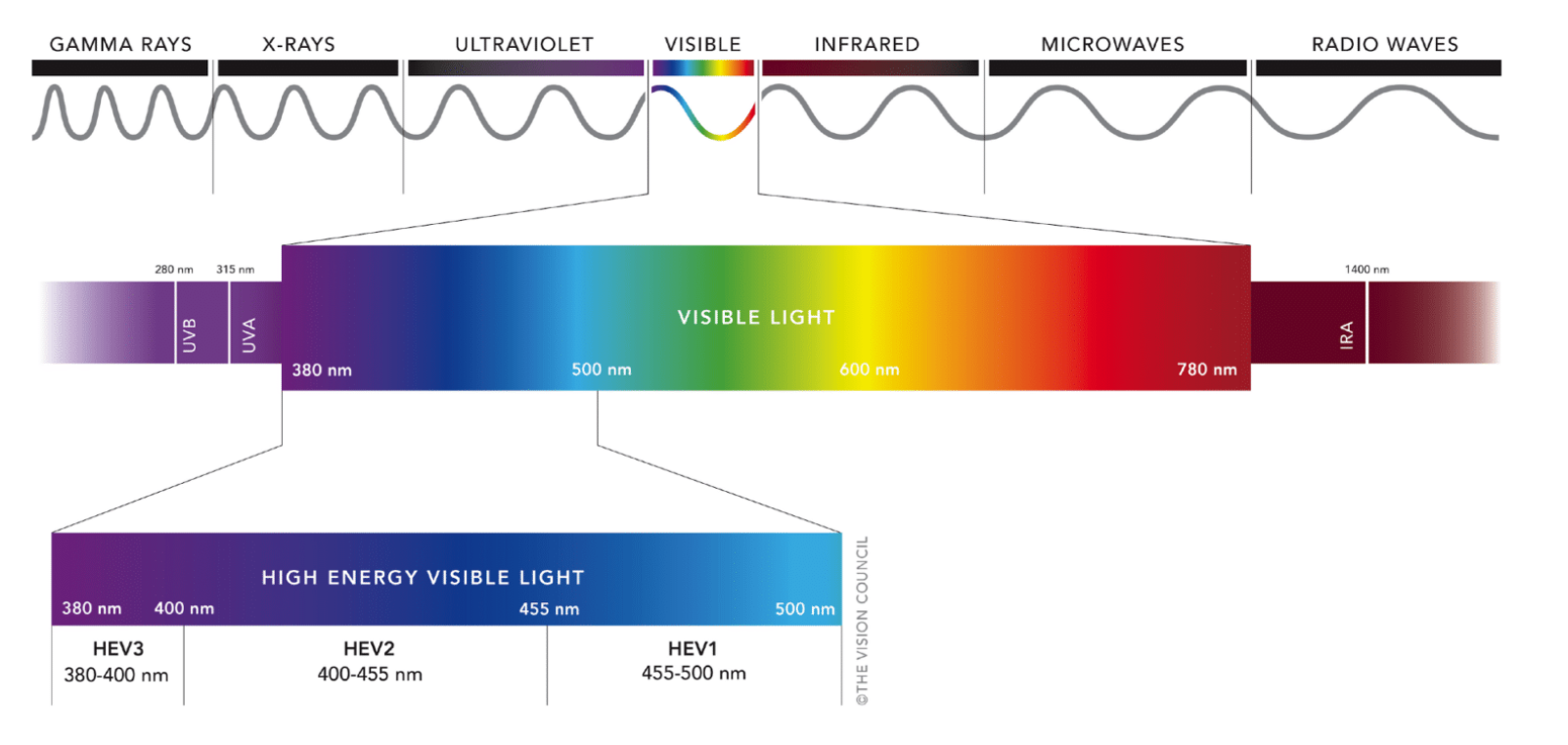Do a quick internet search, and you’ll probably turn up plenty of information stating that blue light from digital devices can hurt your vision—not to mention lead to other alarming effects like sleep disruption and even mental health changes. But there are several misconceptions about blue light, according to John Buch, a Senior Principal Research Optometrist at Johnson & Johnson.
Primarily, there’s confusion about the main source of blue light. While people get up in arms about digital screens, “far and away, the most abundant and strongest source of natural blue-violet radiation is from the sun; so really, anytime you walk outside you’re being exposed to blue light,” Buch says.
He explains that while computer screens, smartphones and televisions do emit blue light, the scale at which they do is vastly different from the sun. “Just 15 minutes of exposure to sunlight has been equated to 13 hours of nonstop looking at a computer screen. That said, it can’t be refuted that computer screens do emit the blue-violet end of the spectrum.”
Setting industry standards: What is blue light?
The electromagnetic spectrum includes a wide range of light, such as ultraviolet, gamma rays and X-rays. Humans can see a portion of the spectrum called visible light, ranging from violet light with a wavelength of 380 nanometers (nm) to blue, green, yellow, orange and red light measuring up to 780 nm. Within that visible spectrum, many people talk about high-energy visible (HEV) light, which is the blueish violet end of the spectrum, and has shorter wavelength and higher energy than other colors, Buch says. And within that HEV spectrum of 380-500 nm light, blue-violet light is an even narrower field, generally defined as light on the spectrum between 380-450 nm.
“Blue light is the most energetic at that range, and it has a lot of unique properties—some of them good, some of them not so good,” Buch says.

Confusingly, many lens makers advertise blue-light blocking technology without clearly defining what ranges the filters block, Buch says. For example, “when you actually go and look at some of these filters on the market, they filter well into the yellow end of the spectrum.”
Recently, Buch participated in the American National Standards Institute (ANSI) Accredited Standards Committee (ASC) Z80 Spectral Bands Task Force, which was a group of industry leaders working together to develop terminology for the spectrum of radiation between 380-500 nm, commonly called blue light. Having an industry standard sets clarity and boundaries so consumers can compare what filters are actually doing and which benefits they provide.
Are there harmful effects of blue light?
Much of the research on the harmful effects of blue light was done to create safety standards for the user of lasers with monochromatic light. Studies find that the range of 435-440 nm with a monochromatic laser is most phototoxic to the retina, causing retinal damage, Buch explains. “But when you walk outside, you’re not being exposed to just one wavelength—it’s a polychromatic world where individual wavelengths are typically not strong enough to cause acute damage.”
However, there are still some disadvantages to blue light in the context of polychromatic light. The original paper—which came out in the 1890s—showing these perceptual disadvantages found that blue-violet light disproportionally scatters. “Perceptually, this is what causes some of the problems related to seeing as clearly as you can,” Buch says. “If you have a lot of light scattering between you and what you want to look at, then what you’re trying to look at will have a lower contrast to it, and it won’t be as crisp.”
Blue light also affects disability glare, essentially the purely visual effect of being “blinded by” a bright light. Disability glare is measured by how much light is needed to affect vision.
Chromatic contrast, which is your ability to detect edges between colors, can also be affected by blue light, Buch says. Not to mention, increased digital device use causes less blinking which can lead to discomfort and cause blue-light to scatter more, which can impact visual clarity.
But it’s not all bad: “A lot of people report good effects of blue light, too,” Buch says. “It’s been associated with a positive effect on mood, alertness and reaction times.”
Within the last 10 to 15 years, there has also been research, mostly focused on animal models, that promotes the notion that you need this type of HEV to slow down myopia progression. But more research is needed because there’s no conclusive evidence, and only monochromatic light has been studied, which is not representative of the polychromatic world we are exposed to, Buch says.

What percentage of blue light should a lens filter?
Different lenses on the market filter different amounts of blue light. For example, the OptiBlue™ Light Filter that is used in the ACUVUE® OASYS MAX 1-Day contact lenses currently has the highest-level blue-violet light filter in the industry at 60% of blue-violet light within the 380-450 nm range. ±†α
“It’s almost equally important to say we are still passing about 40% of that light; because blue light does have positive effects on alertness and reaction times, it’s important to still be able to see this range,” Buch says.
How will lens technology advance in the future?
In November 2024, Johnson & Johnson presented data at the American Academy of Optometry conference that showed that wearing ACUVUE® OASYS MAX 1-Day contact lenses also improves brightness perception.
“We’ve gotten really good at understanding how to incorporate chromophores (which are molecules that absorb certain wavelengths and pass others) into our product,” says Buch. “We’re excited to think about what else we can do with that technology.”
Learn about more Johnson & Johnson innovations in eye health
Click here
± Filtering of HEV light by contact lenses has not been demonstrated to confer any health benefit to the user, including but not limited to retinal protection, protection from cataract progression, reduced eye strain, improved contrast, improved acuity, reduced glare, improved low light vision, or improved circadian rhythm/sleep cycle. The Eye Care Professional should be consulted for more information.
† Versus publicly available information for standard daily use contact lenses as of December 2023.
α Package insert for ACUVUE OASYS MAX 1-Day Contact Lens, and Multifocal Contact Lens
Important Safety Information: ACUVUE® Contact Lenses are indicated for vision correction. As with any contact lens, eye problems, including corneal ulcers, can develop. Some wearers may experience mild irritation, itching or discomfort. Lenses should not be prescribed if patients have any eye infection, or experience eye discomfort, excessive tearing, vision changes, redness or other eye problems. Consult the package insert for complete information. Complete information is also available from Johnson & Johnson Vision Care, Inc. by calling 1-800-843-2020, or by visiting www.jnjvisionpro.com
2024PP17630
.jpg&w=3840&q=75)